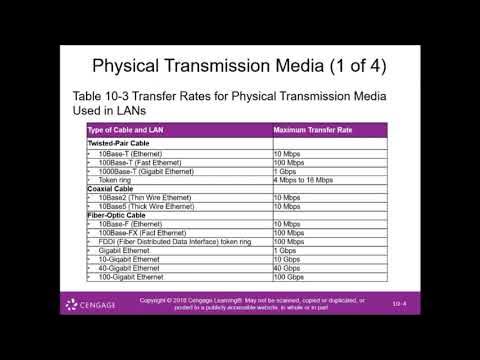How Does LIGHT Carry Data? - Fiber Optics Explained
Summary
TLDRThis video explains how fiber optic networking works, comparing it to sending secret messages with Morse code and a flashlight. It delves into the concept of total internal reflection, where light is transmitted through optical fibers made of glass or plastic with a core and cladding. It highlights the use of repeaters and amplifiers to maintain signal strength over long distances. Fiber optics are more efficient and versatile than copper, finding applications in communication, medicine, and engineering. The video concludes with a sponsor plug for learning platform Brilliant.
Takeaways
- 💡 Fiber optic networks send data using light pulses, similar to how Morse code is sent via flashlight.
- 🌍 Fiber optic cables can carry light across vast distances, including under oceans, to support global communication.
- 🔦 Unlike a flashlight that scatters light over long distances, fiber optics use total internal reflection to guide light efficiently.
- 🧪 Optical fibers are made of a core surrounded by cladding, with each layer having different refractive indices to reflect light properly.
- 🔄 The process of total internal reflection ensures light bounces along the core without escaping into the cladding.
- ⚙️ Over long distances, imperfections in fiber optics cause light to scatter, requiring repeaters or amplifiers to boost the signal.
- 🔌 Repeaters convert weakened optical signals into electronic ones and back to light, allowing for continuous transmission over long distances.
- 🔋 Amplifiers directly strengthen the optical signal using doped fibers that re-emit light without converting it to an electrical signal.
- 💰 Fiber optics are more cost-effective, power-efficient, and reliable for long-distance communication than traditional copper wiring.
- 🏥 Beyond communication, fiber optics are used in fields like medicine (e.g., endoscopy) and engineering, thanks to their flexibility and small size.
Q & A
What is the basic principle behind fiber optic networking?
-Fiber optic networking works by encoding data in pulses of light that travel through optical fibers, carrying information over long distances, such as phone calls and internet data.
How does light travel efficiently through fiber optic cables without scattering?
-Fiber optic cables utilize a phenomenon called total internal reflection. Light is kept inside the core of the optical fiber by bouncing off the cladding, which has a lower refractive index than the core, allowing light to travel long distances without scattering.
What materials are typically used to make the core and cladding of fiber optic cables?
-The core of fiber optic cables is often made of pure glass, such as silicon dioxide, while the cladding can be doped with chemicals to lower its refractive index, or vice versa, where the core itself is doped to raise its refractive index.
What is total internal reflection, and why is it important for fiber optics?
-Total internal reflection is a physical phenomenon where light, hitting a boundary at a shallow angle, is reflected rather than passing through. In fiber optics, this ensures that light remains trapped inside the core, allowing it to travel over long distances without loss.
Why does the light signal weaken over long distances in fiber optic cables?
-Even with high-quality optical fibers, small imperfections cause some light to scatter, weakening the signal as it travels. Over long distances, this makes the signal too weak to be read without amplification.
What are repeaters and how do they work in fiber optic systems?
-Repeaters are devices placed along the fiber optic cable that convert the weakened light signal into an electronic signal. This electronic signal is then converted back into light and sent down the cable to continue its journey.
What is the advantage of using amplifiers instead of repeaters in modern fiber optic systems?
-Amplifiers directly amplify the light signal using optical fibers doped with chemicals, making the process faster and less complex than using repeaters, which require signal conversion.
What are the main advantages of fiber optics over copper wiring for long-distance communication?
-Fiber optics are more cost-effective, power-efficient, and capable of transmitting data over longer distances without requiring frequent signal boosts. They are also thinner and don't cause electromagnetic interference.
How can fiber optic cables transmit large amounts of data efficiently?
-Fiber optic cables can bundle multiple fibers, each carrying multiple wavelengths of light, allowing for the transmission of enormous amounts of data while occupying less physical space compared to other systems.
What are some non-communication applications of fiber optic technology?
-Fiber optics are used in endoscopy for medical procedures, plumbing, and engineering due to their flexibility and ability to reach hard-to-access spaces.
Outlines

Dieser Bereich ist nur für Premium-Benutzer verfügbar. Bitte führen Sie ein Upgrade durch, um auf diesen Abschnitt zuzugreifen.
Upgrade durchführenMindmap

Dieser Bereich ist nur für Premium-Benutzer verfügbar. Bitte führen Sie ein Upgrade durch, um auf diesen Abschnitt zuzugreifen.
Upgrade durchführenKeywords

Dieser Bereich ist nur für Premium-Benutzer verfügbar. Bitte führen Sie ein Upgrade durch, um auf diesen Abschnitt zuzugreifen.
Upgrade durchführenHighlights

Dieser Bereich ist nur für Premium-Benutzer verfügbar. Bitte führen Sie ein Upgrade durch, um auf diesen Abschnitt zuzugreifen.
Upgrade durchführenTranscripts

Dieser Bereich ist nur für Premium-Benutzer verfügbar. Bitte führen Sie ein Upgrade durch, um auf diesen Abschnitt zuzugreifen.
Upgrade durchführenWeitere ähnliche Videos ansehen

Module 10 Communicating Digital Content Wired and Wireless Networks and Devices PART5

What is Ethernet?

Free CCNA | Interfaces and Cables | Day 2 | CCNA 200-301 Complete Course

Computer Networking in 100 Seconds

What is WDM (Wavelength Division Multiplexer)? - FO4SALE.COM

Cara Cek Redaman Kabel FIBER OPTIC Dengan Mudah | Cara Dapatkan Redaman Fiber Optik Yang Bagus
5.0 / 5 (0 votes)
